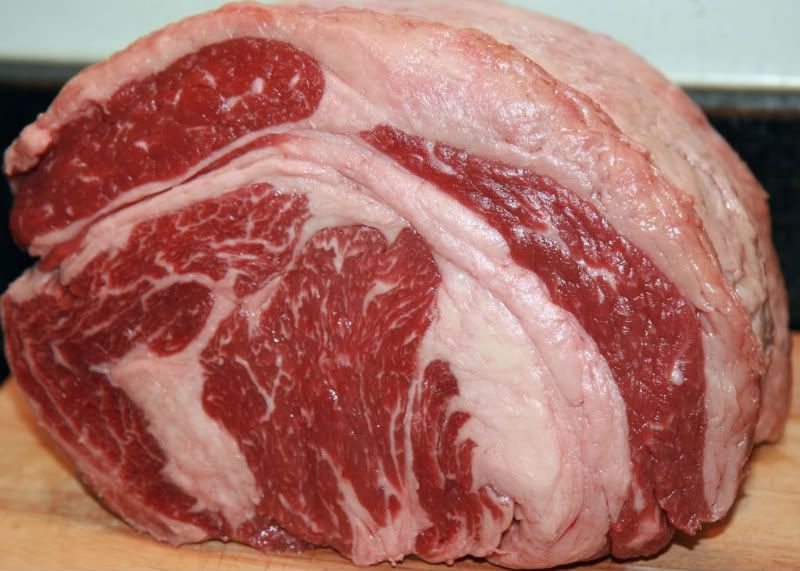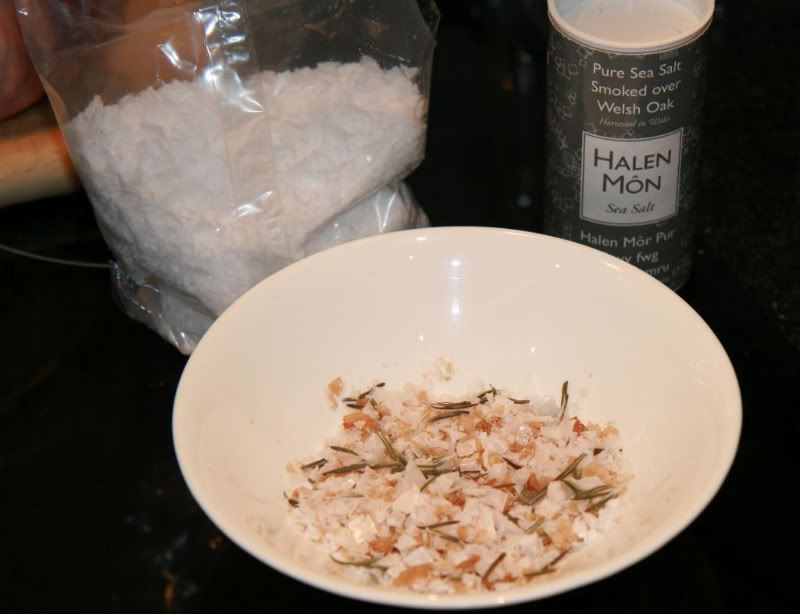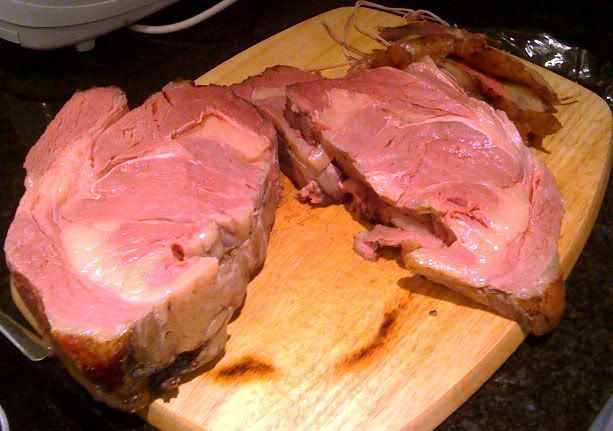Soldato
Thought it was about time i did a write up on this.
First off, some background.
Why cook a joint of meat for so long?
So the aim of this is to cook the beef at a constant temperature below which it starts to overcook. As beef reaches 58C the moisture within starts to get squeezed out. These juices contain myoglobin, which gives the meat the red colour (it's not actually blood), which then oxidises and the meat begins to turn that unpleasant grey colour. Hence if we were to cook the meat for 24hrs at 60+C, we would most likely end up with a joint that's gone rather dry and horrible, so temperature is important here. I would recommend reading up on Heston Blumenthal and Harold McGee for further info around this.
For this joint I've decided to cook it at approx 55 celcius.
Before we start, you do need a few special tools for this:
Next you'll need some meat. Although this thread is about beef, this technique works equally well with Lamb (using the same temperature). I often do legs of lamb this way and the result is spectacular.
For my beef I've gone for a rib - it is by far the best joint of beef in my opinion. Some people are put off by the fattyness, but believe me that's the best bit - it's where all the flavour is! I got the joint being used in this thread from Nottingham farmers market - it's from red leicester cattle:

You should be able to tell a good joint of beef just by looking at it. This has been aged for at least 4 weeks, and most importantly has a very good distribution of intra-muscular fat. This is really important - it lubricates the meat and it gives it the flavour. This is why I rarely buy meat from the supermarket - it's usually far too lean with very little fat as sadly the meat industry in the UK is more inclined to producing meat for consumers that are scared of fat.
Next up, I'm going to salt the meat. This part is optional, but it works well to both season the meat and tenderise it. I'm going to coat the meat in a mixture of flaked sea salt, smoked sea salt and rosemary:

This is a big joint so I'm going to leave it on there for 30mins before washing this off - Don't use table salt otherwise you won't be able to wash it off again, only use the big flaky stuff! The timing of this is a bit of trial and error - the more fat there is in the meat, the faster the salt is absorbed, and the thicker it is, the longer you need. For steaks, 15 mins should be sufficient.
Once the seasoning is rinsed off, pat dry the meat and you're ready for the next step:

For this step, we want to brown the meat all over - NOT to "seal in the moisture" that doesn't happen, and besides we're not going to lose any moisture! This is to both enhance the flavour and also to kill off any surface bacteria in the meat as a bit of a safety measure. If you don't have a blowtorch, you'll need to use a large frying pan.
It should look nice and brown when done.
Now you need to set the oven. Use the oven thermometer to get the temperature as close to 55C as possible. It will vary somewhat but you should be able to achieve that as an average temperature on most ovens. Once set, place the meat in the oven and wait!
You won't be able to overcook the joint as long as the temperature stays constant, but you could possibly undercook it. I additionally use a thermometer probe in the middle of the meat to monitor temperature to ensure cooking is consistent. If you have a really big joint (3 bone rib or more) you may need to use a longer cooking time - but you then go into lengths of times that are impractical for most people.
Finally when done you want to take the meat out and let it rest. I wrap the joint in foil tightly to ensure it doesn't lose temperature and let it rest for upto an hour. Then we can carve:

Sorry I don't have a better photo here - but it should give you an idea of how it looks. Note the colour - it is pink throughout the meat and the cooking is consistent. Sadly I can't describe the texture and flavour, but I can honestly say you'll struggle to beat it. Serve with Yorkshire puddings, roast potatoes and other veg of your choice and you have a winner
Lastly, one thing to note is that making gravy is difficult due to the fact that the juices are retained during cooking. You may want to get some chopped bones from the butcher or something similar to help.
Enjoy
First off, some background.
Why cook a joint of meat for so long?
- Temperature - If the meat is never exposed to a temperature at which point it will begin to overcook, we can end up with an entire joint cooked to the perfect temperature, instead of ending up with a joint that is grey on the outside and red in the middle.
- Texture - By keeping the meat at certain temperatures it will help to breakdown the proteins in the meat and enhance the texture
- Flavour - Increasing the meat to certain temperatures leads to increased enzyme activity enhancing the flavour of the meat (almost like an accelerated ageing process)
So the aim of this is to cook the beef at a constant temperature below which it starts to overcook. As beef reaches 58C the moisture within starts to get squeezed out. These juices contain myoglobin, which gives the meat the red colour (it's not actually blood), which then oxidises and the meat begins to turn that unpleasant grey colour. Hence if we were to cook the meat for 24hrs at 60+C, we would most likely end up with a joint that's gone rather dry and horrible, so temperature is important here. I would recommend reading up on Heston Blumenthal and Harold McGee for further info around this.
For this joint I've decided to cook it at approx 55 celcius.
Before we start, you do need a few special tools for this:
- Oven Thermometer - This is vital. Oven thermostats are useless at best and are often 20-30% out. You can buy an oven thermometer in the shops for not a lot of money which will do the trick
- Blowtorch - You don't have to have a blowtorch, but it makes life easier.
- Probe Thermometer - Not essential, but it gives you piece of mind and allows you to monitor the temperature of the inside of the meat whilst cooking.
Next you'll need some meat. Although this thread is about beef, this technique works equally well with Lamb (using the same temperature). I often do legs of lamb this way and the result is spectacular.
For my beef I've gone for a rib - it is by far the best joint of beef in my opinion. Some people are put off by the fattyness, but believe me that's the best bit - it's where all the flavour is! I got the joint being used in this thread from Nottingham farmers market - it's from red leicester cattle:

You should be able to tell a good joint of beef just by looking at it. This has been aged for at least 4 weeks, and most importantly has a very good distribution of intra-muscular fat. This is really important - it lubricates the meat and it gives it the flavour. This is why I rarely buy meat from the supermarket - it's usually far too lean with very little fat as sadly the meat industry in the UK is more inclined to producing meat for consumers that are scared of fat.
Next up, I'm going to salt the meat. This part is optional, but it works well to both season the meat and tenderise it. I'm going to coat the meat in a mixture of flaked sea salt, smoked sea salt and rosemary:

This is a big joint so I'm going to leave it on there for 30mins before washing this off - Don't use table salt otherwise you won't be able to wash it off again, only use the big flaky stuff! The timing of this is a bit of trial and error - the more fat there is in the meat, the faster the salt is absorbed, and the thicker it is, the longer you need. For steaks, 15 mins should be sufficient.
Once the seasoning is rinsed off, pat dry the meat and you're ready for the next step:

For this step, we want to brown the meat all over - NOT to "seal in the moisture" that doesn't happen, and besides we're not going to lose any moisture! This is to both enhance the flavour and also to kill off any surface bacteria in the meat as a bit of a safety measure. If you don't have a blowtorch, you'll need to use a large frying pan.
It should look nice and brown when done.
Now you need to set the oven. Use the oven thermometer to get the temperature as close to 55C as possible. It will vary somewhat but you should be able to achieve that as an average temperature on most ovens. Once set, place the meat in the oven and wait!
You won't be able to overcook the joint as long as the temperature stays constant, but you could possibly undercook it. I additionally use a thermometer probe in the middle of the meat to monitor temperature to ensure cooking is consistent. If you have a really big joint (3 bone rib or more) you may need to use a longer cooking time - but you then go into lengths of times that are impractical for most people.
Finally when done you want to take the meat out and let it rest. I wrap the joint in foil tightly to ensure it doesn't lose temperature and let it rest for upto an hour. Then we can carve:

Sorry I don't have a better photo here - but it should give you an idea of how it looks. Note the colour - it is pink throughout the meat and the cooking is consistent. Sadly I can't describe the texture and flavour, but I can honestly say you'll struggle to beat it. Serve with Yorkshire puddings, roast potatoes and other veg of your choice and you have a winner

Lastly, one thing to note is that making gravy is difficult due to the fact that the juices are retained during cooking. You may want to get some chopped bones from the butcher or something similar to help.
Enjoy



